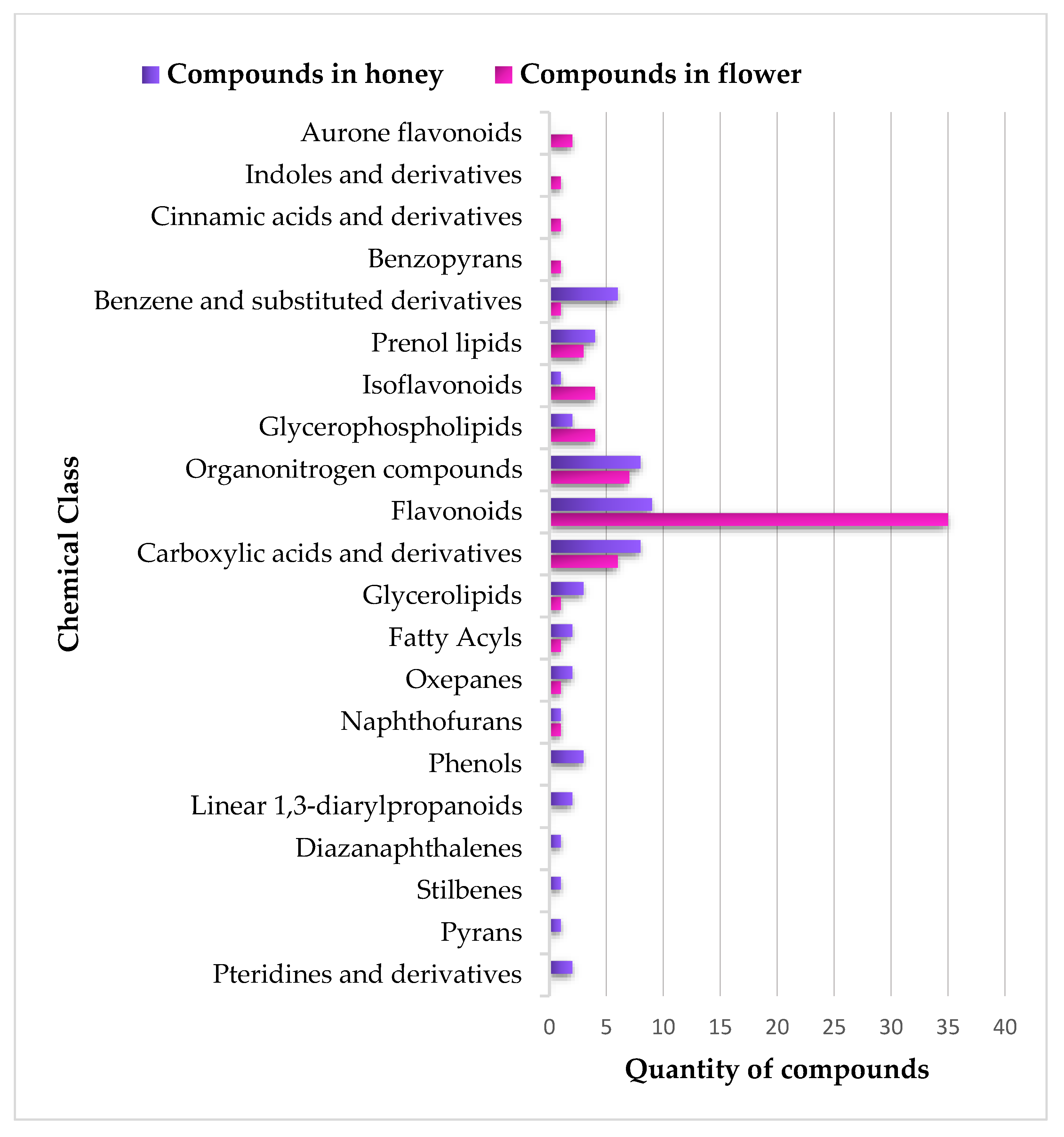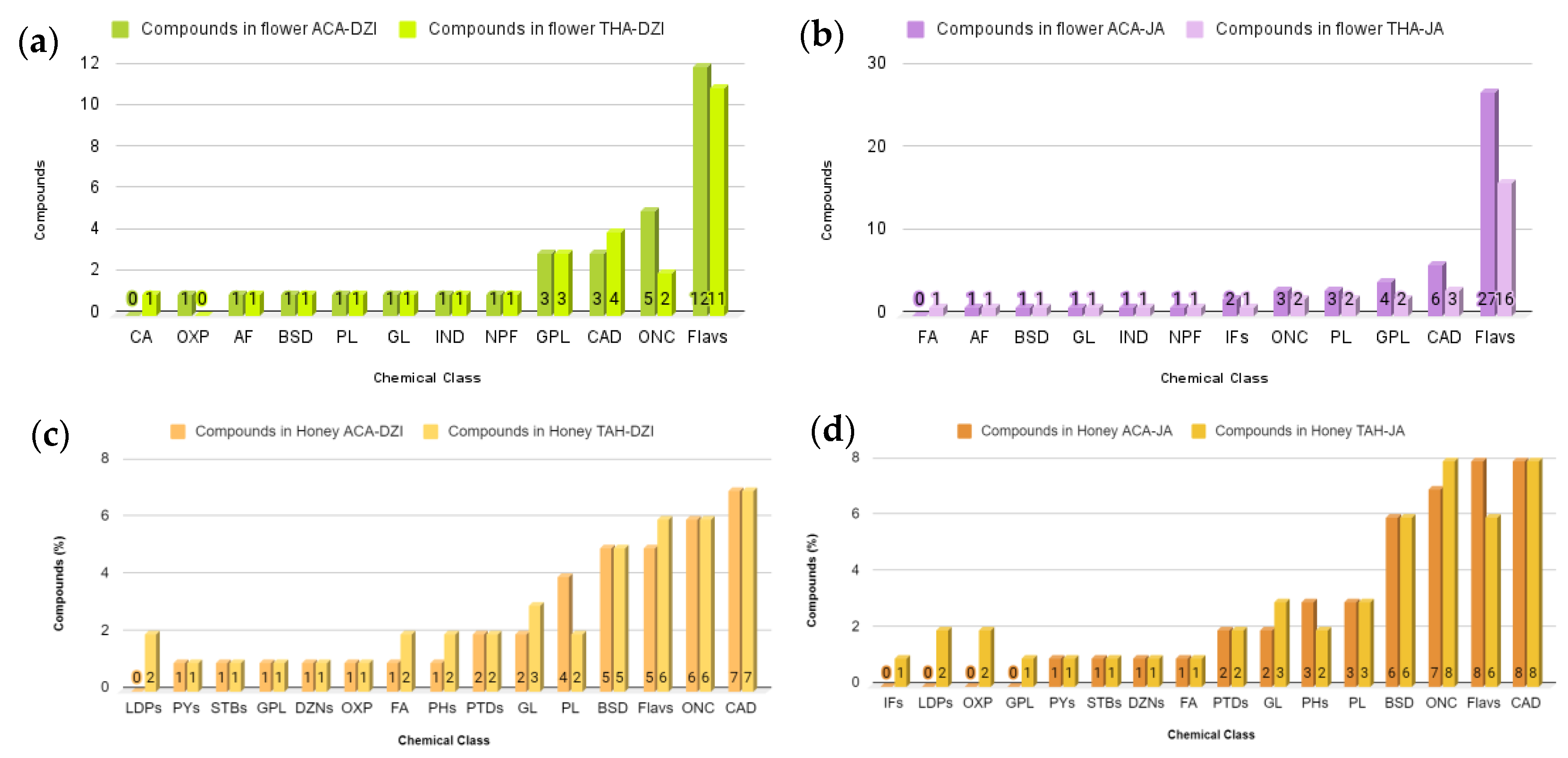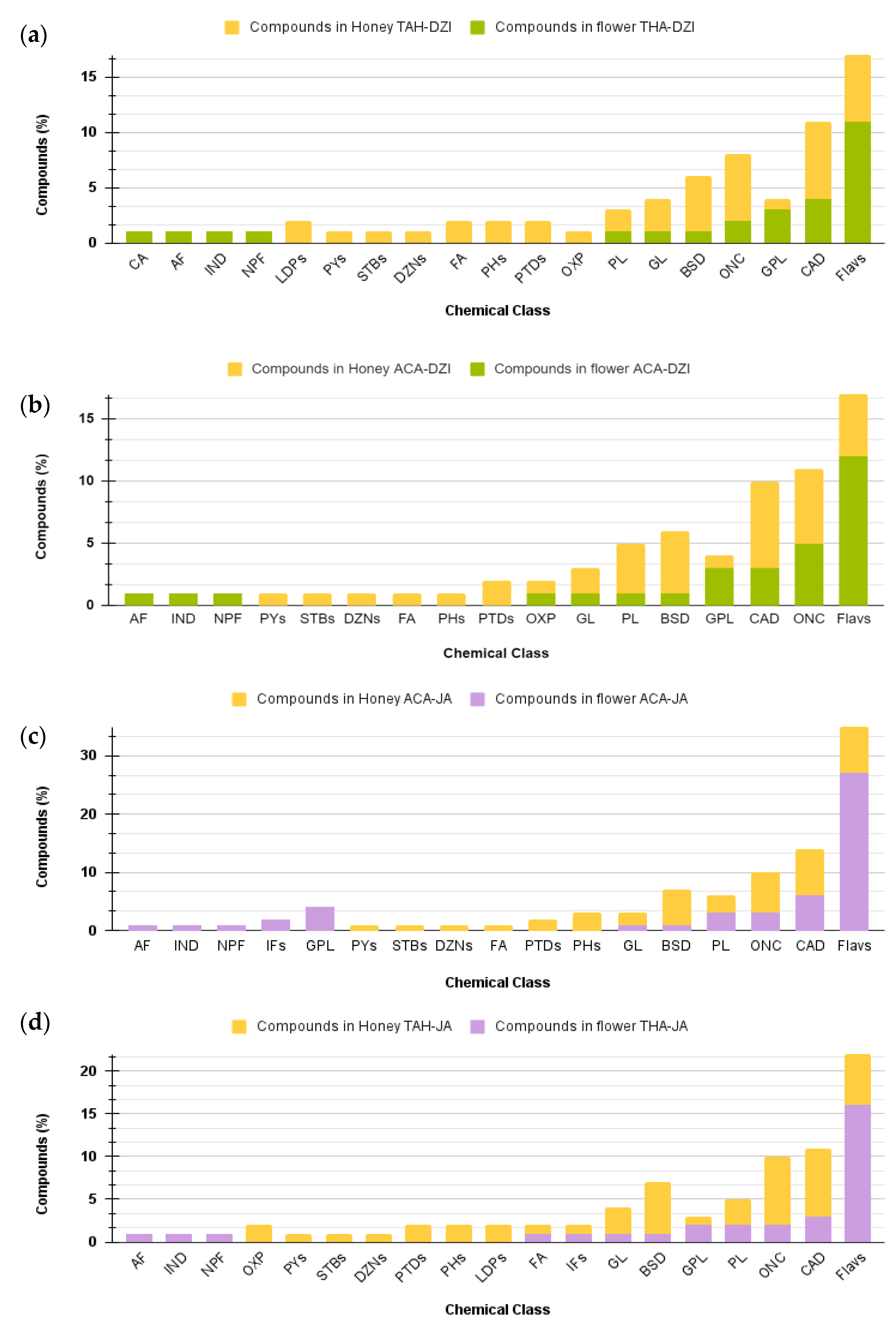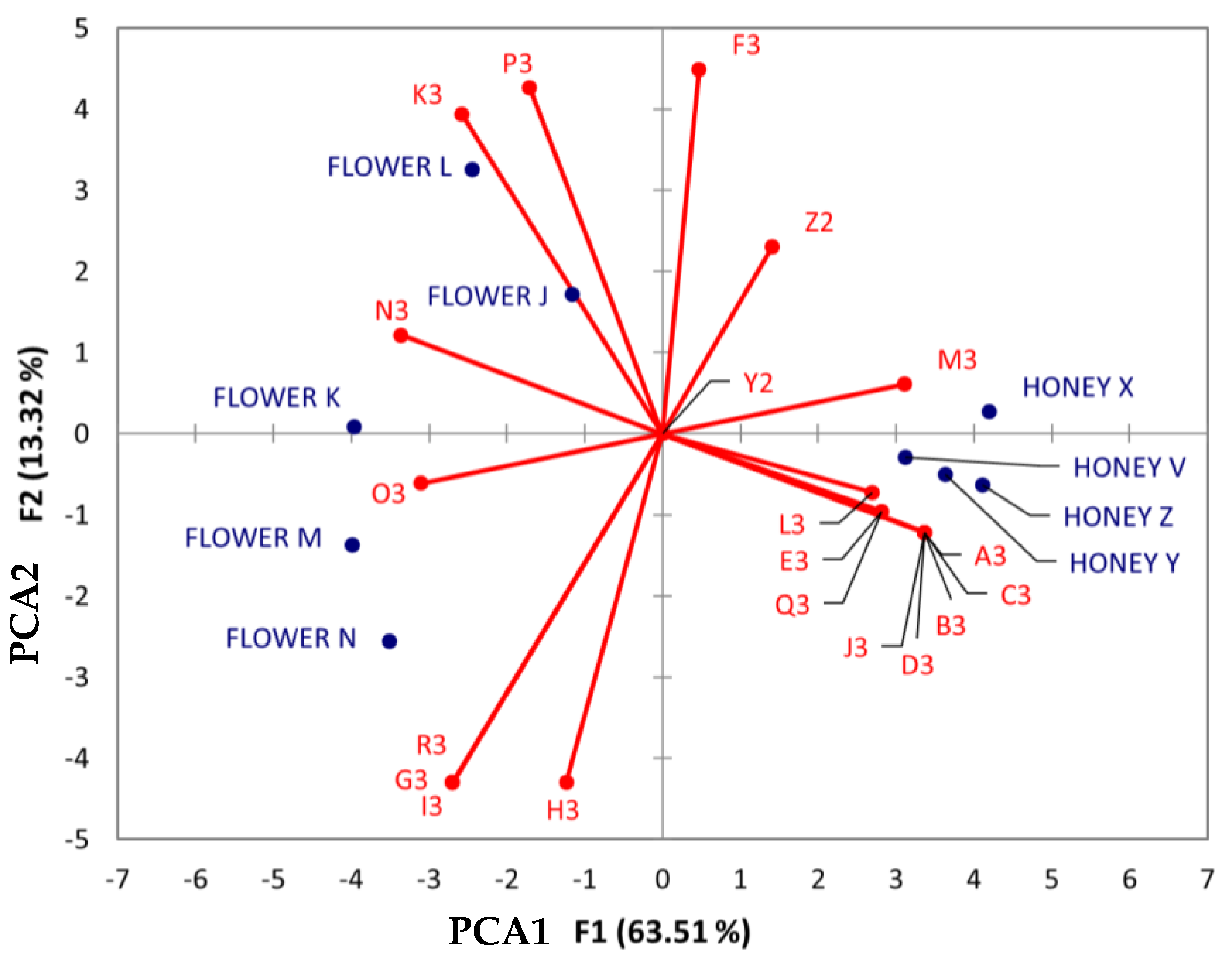Metabolomic Profiling (LC–MS2) of Flowers and Bee Honey of Dzidzilche (Gymnopodium floribundum Rolfe) and Jabin (Piscidia piscipula L. Sarg.) from Yucatán, México
Abstract
1. Introduction
2. Materials and Methods
2.1. Collection of Plant Material
2.2. Selection and Drying of Flowers
Grinding and Sieving
2.3. Determination of Moisture in Flowers and Flower Flours
2.4. Extraction of Metabolites in Flower Flours
2.4.1. Obtainment of Total Polyphenol Content (TPC) and Antioxidant Capacity (AC)
2.4.2. Flower Extraction for LC–MS2
2.5. Extraction of Metabolites in Honey
2.5.1. Honey Dilution for Determination of CTP and AC
2.5.2. Honey Extraction for LC–MS2 Data
2.6. Experimental Design
2.6.1. Determination of TPC in Dzidzilche and Jabin Flower Flours and Honey
2.6.2. Determination of AC in Dzidzilche and Jabin Flower Flours and Honey
2.7. Untargeted LC–MS2 Data Acquisition
LC–MS2 Data Processing
2.8. Statistical Analysis
3. Results
3.1. Collection of Plant Material
3.2. Selection and Drying of Flowers
3.3. Moisture Determination in Flowers and Flower Flours
3.4. TPC and AC of Flower Flours and Honeys
3.5. Identification of Metabolites in Flower Flours and Honey of Dzidzilche and Jabin
Principal Component Analysis (PCA) and Lineal Correlation
4. Discussion
5. Conclusions
Supplementary Materials
Author Contributions
Funding
Data Availability Statement
Conflicts of Interest
References
- Carnevali, F.C.G.; Tapia–Muñoz, J.L.; Duno de Stefano, R.; Ramírez Morillo, I. (Eds.) Flora Ilustrada de la Penín-sula de Yucatán: Listado Florístico; Centro de Investigación Científica de Yucatán, A.C: Mérida, Mexico, 2010; p. 328. [Google Scholar]
- Gobierno de México. Yucatán Se Encuentra Entre Los Principales Productores de Miel Del País. Available online: https://www.gob.mx/agricultura/yucatan/articulos/yucatan-se-encuentra-entre-los-principales-productores-de-miel-del-pais?idiom=es (accessed on 14 August 2023).
- Rogel, F.J.; Carlos, E.G.; Juan Manuel, R.; Álvarez, G. La Apicultura En La Península de Yucatán. Actividad de Subsistencia En un Entorno Globalizado. Rev. Mex. Caribe 2003, 8, 16. [Google Scholar]
- Cairns, C.E.; Villanueva-Gutiérrez, R.; Koptur, S.; Bray, D.B. Bee Populations, Forest Disturbance, and Africanization in Mexico. Biotropica J. Biol. Conserv. 2005, 37, 686–692. [Google Scholar] [CrossRef]
- Santiago, C.B.; Sosa, J.C.; Díaz, A.R.; Trejo, R.N.; May, D.C. Estudio de la flora presente en apiarios de tres municipios en el estado de Yucatán, México. Polibotánica 2022, 3, 1–15. [Google Scholar] [CrossRef]
- Arteaga-Hernández, V.; González-Ávila, M.; Cauich-Rodríguez, J.V. Compuestos fenólicos y actividad antioxidante de plantas de la península de Yucatán. Rev. U.D.C.A. Actual. Divulg. Científica 2014, 17, 29–38. [Google Scholar]
- Gómez-Caravaca, A.M.; Verardo, V.; Toselli, M.; Segura-Carretero, A.; Fernández-Gutiérrez, A.; Caboni, M.F. Actividad anti-oxidante y contenido fenólico total de extractos de hojas de doce especies de plantas seleccionadas de la Península de Yucatán, México. Rev. Mex. Cienc. Forest. 2011, 2, 7–18. [Google Scholar]
- Stefano, R.D.; Morillo, I.M.; Tapia-Muñoz, J.L.; Hernández-Aguilar, S.; Can, L.L.; Cetzal-Ix, W.; Méndez-Jiménez, N.; Zamora-Crescencio, P.; Gutiérrez-Báez, C.; Carnevali-Fernaández-Concha , G. Aspectos generales de la flora vascular de la Península de Yucatán, México. Bot. Sci. 2018, 96, 512–532. [Google Scholar] [CrossRef]
- Nowicka, P.; Wojdyło, A. Anti-Hyperglycemic and Anticholinergic Effects of Natural Antioxidant Contents in Edible Flowers. Antioxidants 2019, 8, 308. [Google Scholar] [CrossRef]
- Pérez-Sarabia, J.E.; Duno de Stefano, R.; Carnevali Fernández-Concha, G.; Ramírez Morillo, I.; Méndez-Jiménez, N.; Zamo-ra-Crescencio, P.; Gutierrez-Báez, C.; Cetzal-Ix, W. El conocimiento florístico de la Península de Yucatán, México, actualización y colecciones botánicas. In Proceedings of the XX Congreso Mexicano de Botánica, Ciudad de, Mexico, Mexico, 4–9 September 2016. [Google Scholar]
- Rosado-Vallado, M.; Brito-Loeza, W.; Mena-Rejón, G.; Quintero-Marmol, E.; Flores-Guido, J. Antimicrobial activity of Fabaceae species used in Yucatan traditional medicine. Fitoterapia 2000, 71, 570–573. [Google Scholar] [CrossRef]
- Canché-Collí, C.; Jiménez, L.N.L.; Rodríguez, R.; Canto, A. El jabín y los secretos de su néctar. Ecofronteras 2022, 26, 2–5. [Google Scholar]
- Zamora Crescencio, P.; Flores Guido, J.S.; Ruenes Morales, R. Flora útil y su manejo en el cono sur del estado de Yucatán, México. Polibotánica 2009, 28, 227–250. [Google Scholar]
- Villanueva-Gutiérrez, R.; Moguel-Ordóñez, Y.B.; Echazarreta-González, C.M.; Arana-López, G. Monofloral honeys in the Yucatán Peninsula, Mexico. Grana 2009, 48, 214–223. [Google Scholar] [CrossRef]
- Escobar-Rivera, P.; González-Mujica, F.; Rodríguez-Amado, J.; lejandro Cruz Sánchez, T. Composición química, actividades antioxidantes y antiinflamatorias de la corteza de Piscidia piscipula L. Aliment. Chem. Toxicol. 2019, 123, 476–483. [Google Scholar] [CrossRef]
- Hernández-Moreno, L.V.; Salazar, J.R.; Pabón, L.C.; Hernández-Rodríguez, P. Antioxidant activity and quantification of phenols and flavonoids of Colombian plants used in urinary tract infections. Rev. U.D.C.A Actual Divulg. Cient. 2022, 25, 1–7. Available online: http://www.scielo.org.co/pdf/rudca/v25n1/0123-4226-rudca-25-01-e1690.pdf (accessed on 23 August 2023).
- Mohtashami, L.; Amiri, M.S.; Ayati, Z.; Ramezani, M.; Jamialahmadi, T.; Emami, S.A.; Sahebkar, A. Ethnobotanical uses, phytochemistry and pharmacology of different Rheum Species (Polygonaceae): A. Review. In Pharmacological Properties of Plant-Derived Natural Products and Implications for Human Health; Barreto, G.E., Sahebkar, A., Eds.; Advances in Experimental Medicine and Biology Series; Springer: Cham, Switzerland, 2021; Volume 1308, pp. 1–22. [Google Scholar] [CrossRef]
- Moguel-Ordóñez, Y.; Echazarreta-Gonzalez, C.; Mora-Escobedo, R. Fisicoquímica de la miel de abeja Apis mellifera producida en el estado de Yucatán durante diferentes etapas del proceso de producción y tipos de floración. Técnica Pecu. México 2005, 43, 323–334. [Google Scholar]
- Ortíz-Ocampo, G.I.; Sandoval-Castro, C.A.; González-Pech, P.G.; Mancilla-Montelongo, G.; Ventura-Cordero, J.; Castañeda-Ramírez, G.S.; Tun-Garrido, J.; Torres-Acosta, J.F.d.J. Month of Harvest and Leaf Age Impact the Bromatological Composition and Polyphenol Content of Gymnopodium floribundum Rolfe Leaves. Agriculture 2022, 12, 1110. [Google Scholar] [CrossRef]
- Cuevas-Glory, L.; Sosa-Moguel, O.; Ortiz-Vázquez, E.; Sauri-Duch, E.; Pino, A. Volatile constituents of tzizilché flower (Gymnopodium floribundum Rolfe) from Yucatán Peninsula, Mexico. J. Essent. Oil Res. 2012, 24, 359–361. [Google Scholar] [CrossRef]
- Ortíz-Ocampo, G.I.; Sandoval-Castro, C.A.; González-Pech, P.G.; Mancilla-Montelongo, G.; Ventura-Cordero, J.; Castañeda-Ramírez, G.S.; Pérez, J.I.C.; Leal, C.C.; Torres-Acosta, J.F.d.J. El Mes de Cosecha y la Edad de la Hoja Impact. Rev. Mex. Cienc. Pecu. 2020, 12, 1289–1303. [Google Scholar] [CrossRef]
- Yang, L.; Wen, K.-S.; Ruan, X.; Zhao, Y.-X.; Wei, F.; Wang, Q. Response of Plant Secondary Metabolites to Environmental Factors. Molecules 2018, 23, 762. [Google Scholar] [CrossRef]
- Cheynier, V.; Comte, G.; Davies, K.M.; Lattanzio, V.; Martens, S. Plant phenolics: Recent advances on their biosynthesis, genetics, and ecophysiology. Plant Physiol. Biochem. 2013, 72, 1–20. [Google Scholar] [CrossRef]
- García-Lara, S.; Dzib, G.; Cetzal-Ix, W. Flora Melífera de la Península de Yucatán, México: Estrategia Para Incrementar la Pro-ducción de Miel en los Periodos de. CICY. Available online: https://www.cicy.mx/Documentos/CICY/Desde_Herbario/2019/2019-09-05-Cetzal-Noguera-Martinez-Flora-melifera-de-PY.pdf (accessed on 25 August 2023).
- Wang, J.; Qing, X.L. Chapter 3—Chemical Composition, Characterization, and Differentiation of Honey Botanical and Geo-Graphical Origins; Steve Taylor, L., Ed.; Advances in Food and Nutrition Research; Academic Press: New York, NY, USA, 2011; Volume 62, pp. 89–137. [Google Scholar] [CrossRef]
- Anklam, E. A review of the analytical methods to determine the geographical and botanical origin of honey. Food Chem. 1998, 63, 549–562. [Google Scholar] [CrossRef]
- Guo, P.; Deng, Q.; Lu, Q. Anti-alcoholic effects of honeys from different floral origins and their correlation with honey chemical compositions. Food Chem. 2019, 286, 608–615. [Google Scholar] [CrossRef] [PubMed]
- Kortesniemi, M.; Rosenvald, S.; Laaksonen, O.; Vanag, A.; Ollikka, T.; Vene, K.; Yang, B. Sensory and chemical profiles of Finnish honeys of different botanical origins and consumer preferences. Food Chem. 2018, 246, 351–359. [Google Scholar] [CrossRef] [PubMed]
- Cherchi, A.; Spanedda, L.; Tuberoso, C.; Cabras, P. Solid-phase extraction and high-performance liquid chromatographic determination of organic acids in honey. J. Chromatogr. A 1994, 669, 59–64. [Google Scholar] [CrossRef]
- Toma´s-Barbera´n, F.A.; Martos, I.; Ferreres, F.; Radovic, B.S.; Anklam, E. HPLC flavonoid profiles as markers for the botanical origin of European unifloral honeys. Sci. Food Agric. 2001, 81, 485–496. [Google Scholar] [CrossRef]
- Toma´s-Barbera´n, F.A.; Garcı´a-Viguera, C.; Vit-Olivier, P.; Ferreres, F.; Toma´s-Lorente, F. Flavonoids in honey of different geographical origin. Z. Lebensm. Unters. Forsch. 1993, 196, 38–44. [Google Scholar] [CrossRef]
- Oney-Montalvo, J.E.; Avilés-Betanzos, K.A.; Ramírez-Rivera, E.J.; Ramírez-Sucre, M.O.; Rodríguez-Buenfil, I.M. Polyphenols Content in Capsicum chinense Fruits at Different Harvest Times and Their Correlation with the Antioxidant Activity. Plants 2020, 9, 1394. [Google Scholar] [CrossRef] [PubMed]
- Chel-Guerrero, L.D.; Oney-Montalvo, J.E.; Rodríguez-Buenfil, I.M. Phytochemical Characterization of By-Products of Habanero Pepper Grown in Two Different Types of Soils from Yucatán, Mexico. Plants 2021, 10, 779. [Google Scholar] [CrossRef] [PubMed]
- Avilés-Betanzos, K.A.; Cauich-Rodríguez, J.V.; Ramírez-Sucre, M.O.; Rodríguez-Buenfil, I.M. Optimization of Spray-Drying Conditions of Microencapsulated Habanero Pepper (Capsicum chinense Jacq.) Extracts and Physicochemical Characterization of the Microcapsules. Polibotánica 2023, 11, 1238. [Google Scholar] [CrossRef]
- Contreras-Angulo, L.A.; Moreno-Ulloa, A.; Carballo-Castañeda, R.A.; León-Felix, J.; Romero-Quintana, J.G.; Aguilar-Medina, M.; Ramos-Payán, R.; Heredia, J.B. Metabolomic Analysis of Phytochemical Compounds from Agricultural Residues of Eggplant (Solanum melongena L.). Molecules 2022, 27, 7013. [Google Scholar] [CrossRef]
- Al-Mamary, M.; Al-Meeri, A.; Al-Habori, M. Antioxidant Activities and total phenolics of different types of honey. Nutr. Res. 2002, 22, 1041–1047. [Google Scholar] [CrossRef]
- Singleton, V.L.; Orthofer, R.; Lamuela-Raventos, R.M. Analysis of total phenols and other oxidation substrates and antioxidants by means of Folin-Ciocalteu reagent. Method Enzym. 1999, 299, 152–178. [Google Scholar] [CrossRef]
- Brand-Williams, W.; Cuvelier, M.E.; Berset, C. Use of a free radical method to evaluate antioxidant activity. LWT Food Sci. Technol. 1995, 28, 25–30. [Google Scholar] [CrossRef]
- Holman, J.D.; Tabb, D.L.; Mallick, P. Employing ProteoWizard to convert raw mass spectrometry data. Curr. Protoc. Bioinform. 2014, 46, 13.24.1–13.24.9. [Google Scholar] [CrossRef] [PubMed]
- Aron, A.T.; Gentry, E.C.; McPhail, K.L.; Nothias, L.-F.; Nothias-Esposito, M.; Bouslimani, A.; Petras, D.; Gauglitz, J.M.; Sikora, N.; Vargas, F.; et al. Reproducible molecular networking of untargeted mass spectrometry data using GNPS. Nat. Protoc. 2020, 15, 1954–1991. [Google Scholar] [CrossRef] [PubMed]
- Schymanski, E.L.; Jeon, J.; Gulde, R.; Fenner, K.; Ruff, M.; Singer, H.P.; Hollender, J. Identifying Small Molecules via High Res-olution Mass Spectrometry: Communicating Confidence. Env. Sci Technol 2014, 48, 2097–2098. [Google Scholar] [CrossRef] [PubMed]
- Cao, L.; Guler, M.; Tagirdzhanov, A.; Lee, Y.-Y.; Gurevich, A.; Mohimani, H. MolDiscovery: Learning mass spectrometry fragmentation of small molecules. Nat. Commun. 2021, 12, 3718. [Google Scholar] [CrossRef] [PubMed]
- Mohimani, H.; Gurevich, A.; Shlemov, A.; Mikheenko, A.; Korobeynikov, A.; Cao, L.; Shcherbin, E.; Nothias, L.-F.; Dorrestein, P.C.; Pevzner, P.A. Dereplication of microbial metabolites through database search of mass spectra. Nat. Commun. 2018, 9, 4035. [Google Scholar] [CrossRef] [PubMed]
- Dührkop, K.; Shen, H.; Meusel, M.; Rousu, J.; Böcker, S. Searching molecular structure databases with tandem mass spectra using CSI:FingerID. Proc. Natl. Acad. Sci. USA 2015, 112, 12580–12585. [Google Scholar] [CrossRef]
- Feunang, Y.D.; Eisner, R.; Knox, C.; Chepelev, L.; Hastings, J.; Owen, G.; Fahy, E.; Steinbeck, C.; Subramanian, S.; Bolton, E.; et al. ClassyFire: Automated Chemical Classification with a Comprehensive, Computable Taxonomy. J. Chemin. 2016, 8, 61. [Google Scholar] [CrossRef]
- Dührkop, K.; Fleischauer, M.; Ludwig, M.; Aksenov, A.A.; Melnik, A.V.; Meusel, M.; Dorrestein, P.C.; Rousu, J.; Böcker, S. SIRIUS 4: A rapid tool for turning tandem mass spectra into metabolite structure information. Nat. Methods 2019, 16, 299–302. [Google Scholar] [CrossRef]
- Ludwig, M.; Nothias, L.-F.; Dührkop, K.; Koester, I.; Fleischauer, M.; Hoffmann, M.A.; Petras, D.; Vargas, F.; Morsy, M.; Aluwihare, L.; et al. Database-independent molecular formula annotation using Gibbs sampling through ZODIAC. Nat. Mach. Intell. 2020, 2, 629–641. [Google Scholar] [CrossRef]
- Ghasemzadeh, A.B.; Ghasemzadeh, N.C.D. Flavonoids and phenolic acids: Role and biochemical activity in plants and human. J. Med. Plants Res. 2011, 5, 6697–6703. [Google Scholar] [CrossRef]
- Zheng, J.; Yu, X.; Maninder, M.; Xu, B. Total phenolics and antioxidants profiles of commonly consumed edible flowers in China. Int. J. Food Prop. 2018, 21, 1524–1540. [Google Scholar] [CrossRef]
- Panche, A.N.; Diwan, A.D.; Chandra, S.R. Flavonoids: An overview. J. Nutr. Sci. 2016, 5, e47. [Google Scholar] [CrossRef] [PubMed]
- Shen, N.; Wang, T.; Gan, Q.; Liu, S.; Wang, L.; Jin, B. Plant flavonoids: Classification, distribution, biosynthesis, and antioxidant activity. Food Chem. 2022, 383, 132531. [Google Scholar] [CrossRef] [PubMed]
- Becerril-Sánchez, A.L.; Quintero-Salazar, B.; Dublán-García, O.; Escalona-Buendía, H.B. Phenolic compounds in honey and their relationship with antioxidant activity, botanical origin, and color. Antioxidants 2021, 10, 1700. [Google Scholar] [CrossRef] [PubMed]
- Bautista, F.; Zinck, J.A. Construction of an Yucatec Maya soil classification and comparison with the WRB framework. J. Ethnobiol. Ethnomed. 2010, 6, 7. [Google Scholar] [CrossRef] [PubMed]
- Bautista-Zúñiga, F.; Jiménez-Osornio, J.; Navarro-Alberto, J.; Manu, A.; Lozano, R. Microrelieve y color del suelo como pro-piedades de diagnóstico en leptosoles cársticos. Tierra Latinoame-Ricana 2003, 21, 1–11. Available online: http://www.redalyc.org/pdf/573/57321101.pdf (accessed on 25 August 2023).
- Oney-Montalvo, J.; Uc-Varguez, A.; Ramírez-Rivera, E.; Ramírez-Sucre, M.; Rodríguez-buenfili, I.M. influence of soil composition on the profile and content of polyphenols in habanero peppers (capsicum Chinese Jacq). Agronomy 2020, 10, 1234. [Google Scholar] [CrossRef]
- Montalvo, J.E.O.; Madrigal, A.C.d.S.; Sucre, M.O.R.; Rodríguez-Buenfil, I.M. Effect of the Soil and Ripening Stage in Capsicum chinense var. Jaguar on the Content of Carotenoids and Vitamins. Horticulturae 2021, 7, 442. [Google Scholar] [CrossRef]
- Feduraev, P.; Skrypnik, L.; Nebreeva, S.; Dzhobadze, G.; Vatagina, A.; Kalinina, E.; Pungin, A.; Maslennikov, P.; Riabova, A.; Krol, O.; et al. Variability of Phenolic Compound Accumulation and Antioxidant Activity in Wild Plants of Some Rumex Species (Polygonaceae). Antioxidants 2022, 11, 311. [Google Scholar] [CrossRef]
- Hussein, S.; El-Magly, U.; Tantawy, M.; Kawashty, S.; Saleh, N. Phenolics of selected species of Persicaria and Polygonum (Polygonaceae) in Egypt. Arab. J. Chem. 2017, 10, 76–81. [Google Scholar] [CrossRef]
- Hallmann, E. Quantitative and qualitative identification of bioactive compounds in edible flowers of black and bristly locust and their antioxidant activity. Biomolecules 2020, 10, 1603. [Google Scholar] [CrossRef] [PubMed]
- Tungmunnithum, D.; Drouet, S.; Lorenzo, J.M.; Hano, C. Characterization of Bioactive Phenolics and Antioxidant Capacity of Edible Bean Extracts of 50 Fabaceae Populations Grown in Thailand. Foods 2021, 10, 3118. [Google Scholar] [CrossRef] [PubMed]
- Desta, K.T.; El-Aty, A.M.A. Millettia isoflavonoids: A comprehensive review of structural diversity, extraction, isolation, and pharmacological properties. Phytochem. Rev. 2023, 22, 275–308. [Google Scholar] [CrossRef] [PubMed]
- Foudah, A.I.; Abdel-Kader, M.S. Isoflavonoids. In Flavonoids—From Biosynthesis to Human Health; InTech: Mexico City, Mexico, 2017. [Google Scholar] [CrossRef][Green Version]
- Araya-Cloutier, C.; den Besten, H.M.W.; Aisyah, S.; Gruppen, H.; Vincken, J.-P. The position of prenylation of isoflavonoids and stilbenoids from legumes (Fabaceae) modulates the antimicrobial activity against Gram positive pathogens. Food Chem. 2017, 226, 193–201. [Google Scholar] [CrossRef] [PubMed]
- Palma, M.; Robert, P.; Holgado, F.; Velasco, J.; Márquez-Ruiz, G. Antioxidant Activity and Kinetics Studies of Quercetin, Epicatechin and Naringenin in Bulk Methyl Linoleate. J. Am. Oil Chem. Soc. 2017, 94, 1189–1196. [Google Scholar] [CrossRef]
- Shay, J.; Elbaz, H.A.; Lee, I.; Zielske, S.P.; Malek, M.H.; Hüttemann, M. Molecular mechanisms and therapeutic effects of (-)-epicatechin and other polyphenols in cancer, inflammation, diabetes, and neurodegeneration. In Oxidative Medicine and Cellular Longevity; Hindawi Publishing Corporation: London, UK, 2015. [Google Scholar] [CrossRef]
- Shabir, I.; Pandey, V.K.; Shams, R.; Dar, A.H.; Dash, K.K.; Khan, S.A.; Bashir, I.; Jeevarathinam, G.; Rusu, A.V.; Esatbeyoglu, T.; et al. Promising bioactive properties of quercetin for potential food applications and health benefits: A review. Front. Nutr. 2022, 9, 999752. [Google Scholar] [CrossRef]
- Gašić, U.M.; Milojković-Opsenica, D.M.; Tešić, L. Polyphenols as possible markers of botanical origin of honey. J. AOAC Int. 2017, 100, 852–861. [Google Scholar] [CrossRef]
- Cheung, Y.; Meenu, M.; Yu, X.; Xu, B. Phenolic acids and flavonoids profiles of commercial honey from different floral sources and geographic sources. Int. J. Food Prop. 2019, 22, 290–308. [Google Scholar] [CrossRef]
- Kasiotis, K.M.; Baira, E.; Iosifidou, S.; Bergele, K.; Manea-Karga, E.; Theologidis, I.; Barmpouni, T.; Tsipi, D.; Machera, K. Characterization of Ikaria Heather Honey by Untargeted Ultrahigh-Performance Liquid Chromatography-High Resolution Mass Spectrometry Metabolomics and Melissopalynological Analysis. Front. Chem. 2022, 10, 924881. [Google Scholar] [CrossRef] [PubMed]
- Lawag, I.L.; Lim, L.-Y.; Joshi, R.; Hammer, K.A.; Locher, C. A Comprehensive Survey of Phenolic Constituents Reported in Monofloral Honeys around the Globe. Foods 2022, 11, 1152. [Google Scholar] [CrossRef] [PubMed]
- Schievano, E.; Finotello, C.; Uddin, J.; Mammi, S.; Piana, L. Objective Definition of Monofloral and Polyfloral Honeys Based on NMR Metabolomic Profiling. J. Agric. Food Chem. 2016, 64, 3645–3652. [Google Scholar] [CrossRef]
- Deadman, B.J. The Flavonoid Profile of New Zealand Manuka Honey. Master Thesis, The University of Waikato, Hamilton, New Zealand, 2009; pp. 1–270. Available online: https://hdl.handle.net/10289/5443 (accessed on 1 March 2023).
- Kuś, P.; Jerković, I.; Jakovljević, M.; Jokić, S. Extraction of bioactive phenolics from black poplar (Populus nigra L.) buds by supercritical CO2 and its optimization by response surface methodology. J. Pharm. Biomed. Anal. 2018, 152, 128–136. [Google Scholar] [CrossRef] [PubMed]
- Hermosín, I.; Chicón, R.M.; Cabezudo, M.D. Free amino acid composition and botanical origin of honey. Food Chem. 2003, 83, 263–268. [Google Scholar] [CrossRef]
- Dimins, F.; Cinkmanis, I.; Radenkovs, V.; Augspole, I.; Valdovska, A. Analysis of 18 Free Amino Acids in Honeybee and Bumblebee Honey from Eastern and Northern Europe and Central Asia Using HPLC-ESI-TQ-MS/MS Approach Bypassing Derivatization Step. Foods 2022, 11, 2744. [Google Scholar] [CrossRef] [PubMed]
- Kowalski, S.; Kopuncová, M.; Ciesarová, Z.; Kukurová, K. Free amino acids profile of Polish and Slovak honeys based on LC–MS/MS method without the prior derivatisation. J. Food Sci. Technol. 2017, 54, 3716–3723. [Google Scholar] [CrossRef]










| Exp | Coded Values | Real Values | Variable Response | |||||
|---|---|---|---|---|---|---|---|---|
| X1 | X2 | X3 | BO | GO | RM | TPC (mg GAE/100 g DM) | AC (% Inhibition) | |
| 1 | −1 | −1 | −1 | Jabin | Tahdziu | Flower | Y1 | Y2 |
| 2 | 1 | −1 | −1 | Dzidzilche | Tahdziu | Flower | Y1 | Y2 |
| 3 | −1 | 1 | −1 | Jabin | Acanceh | Flower | Y1 | Y2 |
| 4 | 1 | 1 | −1 | Dzidzilche | Acanceh | Flower | Y1 | Y2 |
| 5 | −1 | −1 | 1 | Jabin | Tahdziu | Honey | Y1 | Y2 |
| 6 | 1 | −1 | 1 | Dzidzilche | Tahdziu | Honey | Y1 | Y2 |
| 7 | −1 | 1 | 1 | Jabin | Acanceh | Honey | Y1 | Y2 |
| 8 | 1 | 1 | 1 | Dzidzilche | Acanceh | Honey | Y1 | Y2 |
| Moisture (%) | ||
|---|---|---|
| Sample | Initial | Final |
| ACA-DZI | 56.95 ± 1.30 a | 2.91 ± 0.34 bc |
| TAH-DZI | 56.53 ± 1.09 a | 2.58 ± 0.18 ab |
| ACA-JA | 72.26 ± 0.62 b | 2.45 ± 0.27 a |
| TAH-JA | 80.25 ± 0.19 c | 3.33 ± 0.11 c |
| Exp | Coded Values | Real Values | Variables Response | |||||
|---|---|---|---|---|---|---|---|---|
| X1 | X2 | X3 | BO | GO | RM | TPC (mg GAE/100 g DM) | AC (% Inhibition) | |
| 1 | −1 | −1 | −1 | Jabin | Tahdziu | Flower | 347.57 ± 1.33 e | 83.64 ± 0.46 a |
| 2 | 1 | −1 | −1 | Dzidzilche | Tahdziu | Flower | 294 ± 0.11.09 d | 85.3 1± 0.87 b |
| 3 | −1 | 1 | −1 | Jabin | Acanceh | Flower | 661.64 ± 1.98 c | 92.39 ± 0.22 c |
| 4 | 1 | 1 | −1 | Dzidzilche | Acanceh | Flower | 1431.24 ± 15.38 b | 93.63 ± 0.22 d |
| 5 | −1 | −1 | 1 | Jabin | Tahdziu | Honey | 8.70 ± 0.51 a | 13.68 ± 0.75 e |
| 6 | 1 | −1 | 1 | Dzidzilche | Tahdziu | Honey | 9.92 ± 0.56 a | 18.52 ± 0.25 f |
| 7 | −1 | 1 | 1 | Jabin | Acanceh | Honey | 5.38 ± 0.14 a | 21.60 ± 0.36 g |
| 8 | 1 | 1 | 1 | Dzidzilche | Acanceh | Honey | 5.28 ± 0.47 a | 20.32 ± 0.50 h |
Disclaimer/Publisher’s Note: The statements, opinions and data contained in all publications are solely those of the individual author(s) and contributor(s) and not of MDPI and/or the editor(s). MDPI and/or the editor(s) disclaim responsibility for any injury to people or property resulting from any ideas, methods, instructions or products referred to in the content. |
© 2023 by the authors. Licensee MDPI, Basel, Switzerland. This article is an open access article distributed under the terms and conditions of the Creative Commons Attribution (CC BY) license (https://creativecommons.org/licenses/by/4.0/).
Share and Cite
Mendoza-Osorno, A.E.; Avilés-Betanzos, K.A.; Uc-Varguez, A.; Carballo-Castañeda, R.; Moreno-Ulloa, A.; Ramírez-Sucre, M.O.; Rodríguez-Buenfil, I.M. Metabolomic Profiling (LC–MS2) of Flowers and Bee Honey of Dzidzilche (Gymnopodium floribundum Rolfe) and Jabin (Piscidia piscipula L. Sarg.) from Yucatán, México. Processes 2023, 11, 3028. https://doi.org/10.3390/pr11103028
Mendoza-Osorno AE, Avilés-Betanzos KA, Uc-Varguez A, Carballo-Castañeda R, Moreno-Ulloa A, Ramírez-Sucre MO, Rodríguez-Buenfil IM. Metabolomic Profiling (LC–MS2) of Flowers and Bee Honey of Dzidzilche (Gymnopodium floribundum Rolfe) and Jabin (Piscidia piscipula L. Sarg.) from Yucatán, México. Processes. 2023; 11(10):3028. https://doi.org/10.3390/pr11103028
Chicago/Turabian StyleMendoza-Osorno, Andrea Elizabeth, Kevin Alejandro Avilés-Betanzos, Alberto Uc-Varguez, Rommel Carballo-Castañeda, Aldo Moreno-Ulloa, Manuel Octavio Ramírez-Sucre, and Ingrid Mayanin Rodríguez-Buenfil. 2023. "Metabolomic Profiling (LC–MS2) of Flowers and Bee Honey of Dzidzilche (Gymnopodium floribundum Rolfe) and Jabin (Piscidia piscipula L. Sarg.) from Yucatán, México" Processes 11, no. 10: 3028. https://doi.org/10.3390/pr11103028
APA StyleMendoza-Osorno, A. E., Avilés-Betanzos, K. A., Uc-Varguez, A., Carballo-Castañeda, R., Moreno-Ulloa, A., Ramírez-Sucre, M. O., & Rodríguez-Buenfil, I. M. (2023). Metabolomic Profiling (LC–MS2) of Flowers and Bee Honey of Dzidzilche (Gymnopodium floribundum Rolfe) and Jabin (Piscidia piscipula L. Sarg.) from Yucatán, México. Processes, 11(10), 3028. https://doi.org/10.3390/pr11103028








